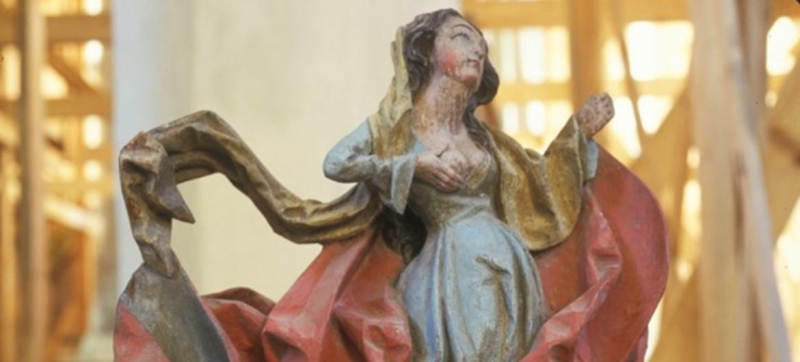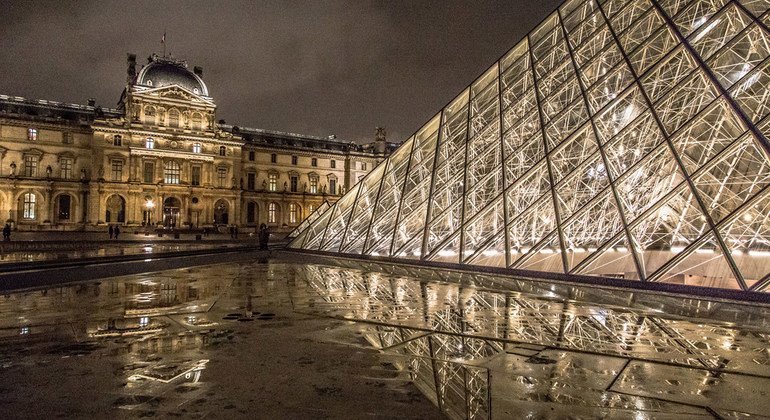
One of the exhibits of the UNESCO Museum of Stolen Cultural Property is a figurine from Estonia. The Stolen Past: How the International Community Is Combating Illicit Trafficking in Cultural Property Culture and education
Last year, more than 37 thousand cultural property, including archaeological artifacts, works of art, coins and musical instruments, were seized during the international Operation Pandora IX. The operation was carried out with the participation of Europol, Interpol and the World Customs Organization, as well as law enforcement and customs authorities from 23 countries, including Ukraine, Poland, Romania, Moldova, Serbia, Bulgaria, Czech Republic, USA and other countries.
In particular, according to official Interpol data, Ukrainian customs seized 87 items of historical value, including icons of St. Seraphim of Sarov and ancient coins, which they tried to illegally export from the country to Poland, Moldova and Romania.
In Spain, a group that looted archaeological sites in the province of Caceres was exposed: the criminals obtained thousands of Roman coins using metal detectors and sold them through social networks. Three people were arrested in Greece for trying to sell five Byzantine icons for 70 thousand euros. These and other incidents indicate the scale of the problem, as well as the need for international cooperation to solve it.
Cultural heritage is not a commodity
As noted by the UN Office on Drugs and Crime (UNODC), smuggling of cultural property is one of the oldest forms of criminal activity and is one of the most profitable types of illicit trafficking in the world, along with weapons and drugs. At the same time Unlike other types that are subject to a complete ban, trade in cultural property itself is not prohibited.
High demand for antiquities and works of art, combined with insufficient regulation, makes this area extremely profitable and at the same time low-risk – especially in conditions crises. Organized criminal networks take advantage of this, operating through extensive schemes and benefiting from both legal and underground markets.
November 14 marks the International Day against Illicit Trafficking in Cultural Property. This date was established by UNESCO in memory of the adoption in 1970 of the Convention on the Means of Prohibiting and Preventing the Illicit Import and Export of Cultural Property, as well as the Illicit Transfer of Ownership thereof. This day is meant to remind us that cultural heritage is not a commodity, but a part of human history that must be protected.
“Illicit trafficking, as well as theft and illegal transfers of cultural property, touches on issues such as cultural rights, cultural identity, our memory, as well as communities and their history,” explained the Director of the Culture Sector’s Cultural Emergencies Unit UNESCO Krista Piccat in an interview with the UN News Service.
Historical sites in zones of armed conflict and political instability are especially vulnerable to smugglers. According to Piccat, in such situations, authorities have new priorities, and archaeological sites or museums are often left without oversight. More smugglers are using online platforms and auctions to sell illegal finds, including items recovered from underwater archaeological sites.
Save artifacts for future use generations
Recently UNESCO condemned the theft of eight priceless cultural objects from the Louvre, which occurred on October 19, 2025. The organization said in a statement that such crimes “jeopardize the preservation, study and transmission to future generations of treasured historical artifacts” while fueling the international trade in stolen cultural property linked to money laundering, tax evasion and even the financing of terrorism.

As noted in the report, illicit trafficking in cultural property knows no borders, and countering it requires long-term efforts and international coordination. UNESCO has worked for decades with Interpol, the World Customs Organization, UNODC, the International Council of Museums and others to strengthen legal frameworks, train museum professionals and customs officials on how to identify stolen objects, and raise public awareness. Since 2023, UNESCO’s courses have trained more than 1,200 professionals from 80 countries, said Krista Piccat.
“We are also working with a partner like the IAEA to explore how nuclear technology can be applied in provenance research. It is also interesting to see how new technologies in the field of artificial intelligence provide us with new opportunities in the fight against illicit trafficking,” – added the UNESCO representative.
At the end of September, UNESCO officially launched the world’s first Virtual Museum of Stolen Cultural Property. The museum uses 3D modeling and virtual reality technologies, allowing users around the world to see digital copies of stolen artifacts. The platform includes educational materials and testimonies from affected communities, as well as a section dedicated to successful examples of the return of cultural property.
“The idea of the museum is that one day it will be empty,” Piccat noted.
She gave an example from her own experience, saying that, being from Estonia, she decided to see what artifacts from her country were included in the collection. Pikkat was curious to learn that Estonia had offered to include some altar sculptures from a small village church on the island. According to her, the artifacts created by Lübeck craftsmen in the 16th century are especially valuable because of their history, which shows that Estonia was part of the Hanseatic League and conducted active trade with Germany. The UNESCO representative emphasized that the value of such artifacts cannot always be measured in money – their true value lies in the historical, cultural and spiritual meaning they have for local communities and society as a whole. The Organization warns that a society deprived of its heritage loses part of its identity and foundation for future development
Returning heritage to its homeland
The international legal framework and intergovernmental cooperation are increasingly making it possible to identify and return to their homeland cultural values illegally exported abroad. Thus, in May 2025, Egypt reportedly received back 25 archaeological items, including a mummy portrait from Fayum, a gold coin from the time of Ptolemy I, the Greek commander and successor of Alexander the Great, and jewelry dating back about 2400 years. These objects were discovered in New York and transferred to Egypt thanks to the coordinated work of the Egyptian consulate, the prosecutor Manhattan and American law enforcement agencies, the media noted. Earlier in dozens of antique items worth more than 2 million euros were returned from New York to Greece and Italy. 6,100 artifacts valued at more than $480 million, and nearly 5,750 of them returned to 31 countries.
UNESCO supports countries in their efforts to identify and recover stolen property.
“We have organized capacity building activities in Central Asia. The idea was to work with countries around Afghanistan to prevent the illegal removal of artifacts from Afghanistan. Then we heard from the National Commission of the Kyrgyz Republic for UNESCO that the border guards who participated in the exercises were able to identify another – not Afghan – artifact,” said Krista Piccat.

In addition, she said, UNESCO is working on the problems of sites that were lost during colonial times, mainly by promoting dialogue on the topic.
Combating criminal networks
Recent examples demonstrate that the application of international legal instruments – in particular the 1970 UNESCO Convention and the 1995 UNIDROIT Convention on Cultural Goods Stolen or Illegally Exported on the Return of Stolen cultural values – produces results. However, this is often a complex process, requiring diplomatic efforts, legal expertise and lengthy negotiations between countries.
In recent years, more and more attention has been paid to digital solutions: electronic registries, databases and blockchain technology, which allow tracking the origin of art objects and antiquities.
Citizens are reminded that when purchasing antiquities and works of art to request official documentation of provenance and avoid transactions with unknown sellers online. Suspicious items can be reported to local law enforcement or directly to Interpol.
Every returned artifact is a restored connection between past and present, a reminder that history and culture belong to us all. International Day November 14 calls for remembering this responsibility – and continuing the work to protect cultural heritage, which knows no borders.
